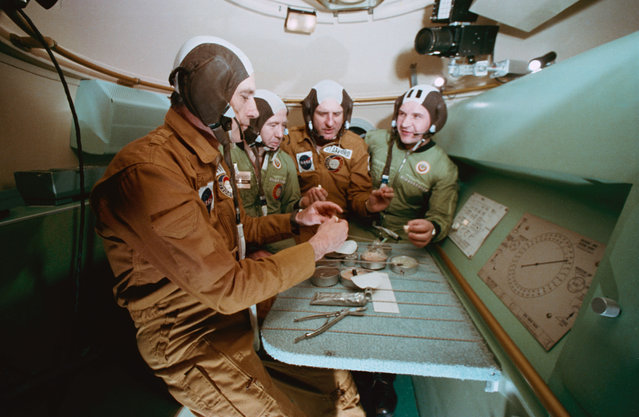
Two American ASTP prime crewmen have a meal with the Soviet ASTP first (prime) crewmen during Apollo-Soyuz Test Project joint crew training at NASA's Johnson Space Center, on February 25, 1975. The four are inside the Soyuz orbital module mock-up in Building 35. They are, left to right, astronaut Donald K. Slayton, docking module pilot of the American crew; cosmonaut Aleksey A. Leonov, commander of the Soviet crew; astronaut Thomas P. Stafford, commander of the American crew; and cosmonaut Valeriy N. Kubasov, engineer on the Soviet crew. The training session simulated activities on the second day in Earth orbit. During the actual mission the other American crewmen, astronaut Vance D. Brand, command module pilot, would be in the Command Module. (Photo by NASA)
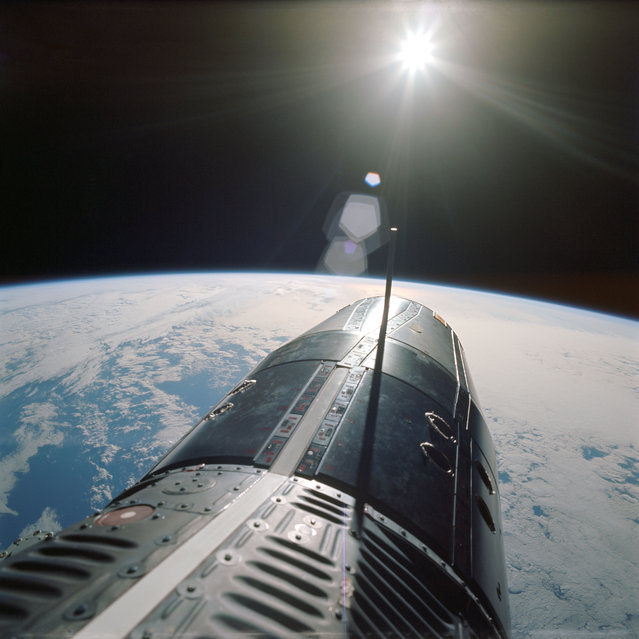
Backdropped over the Pacific Ocean, the nose of the Gemini spacecraft is seen, as photographed by astronaut Eugene A. Cernan, pilot of the Gemini-9A spaceflight, on 5 June 1966. Cernan, who was performing the second spacewalk in NASA history, snapped the picture with a 70mm handheld camera. (Photo by NASA)
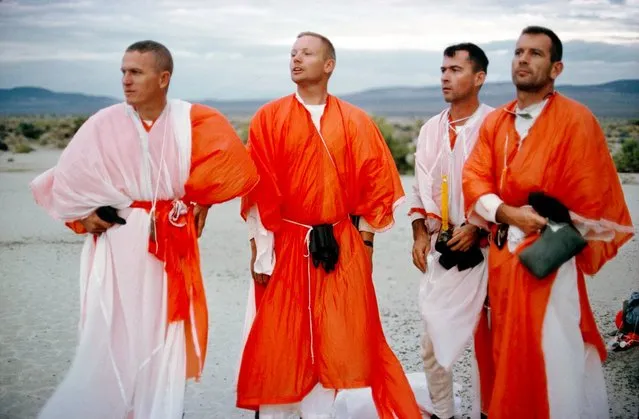
Astronaut John Young, Frank Borman and Neil Armstrong with Deke Slayton are shown during desert survival training, Reno, Nevada STEAD AFB, Reno, NV, on August 13, 1964. Portions of their clothing have been fashioned from parachute material. The purpose of this training was to prepare astronauts in the event of an emergency or faulty landing in a remote area. (Photo by NASA)
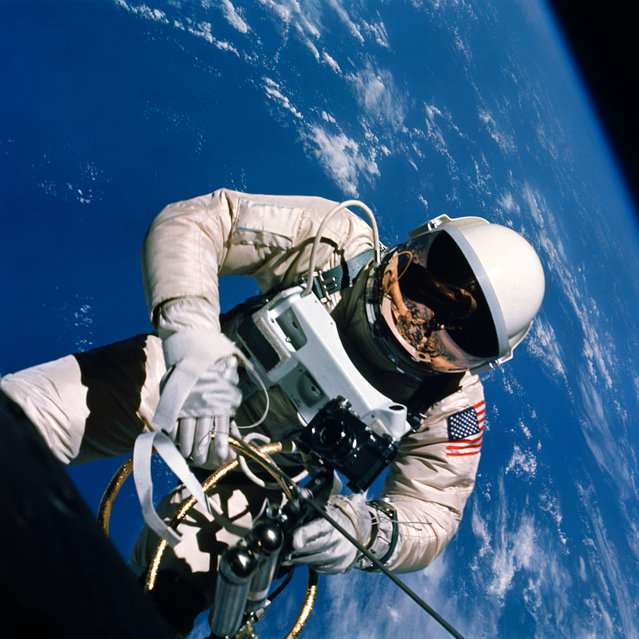
Astronaut Edward H. White II, pilot of the Gemini IV four-day Earth-orbital mission, floats in the zero gravity of space outside the Gemini IV spacecraft, on June 3, 1965. Behind him is the brilliant blue Earth and its white cloud cover. White wears a specially designed spacesuit; and the visor of the helmet is gold plated to protect him against the unfiltered rays of the sun. He wears an emergency oxygen pack, also. He is secured to the spacecraft by a 25-feet umbilical line and a 23-feet tether line, both wrapped in gold tape to form one cord. In his left hand is a Hand-Held Self-Maneuvering Unit (HHSMU) with which he controls his movements in space. Astronaut James A. McDivitt, command pilot of the mission, remained inside the spacecraft. Astronaut White died in the Apollo/Saturn 204 fire at Cape Kennedy on January 27, 1967. (Photo by NASA)
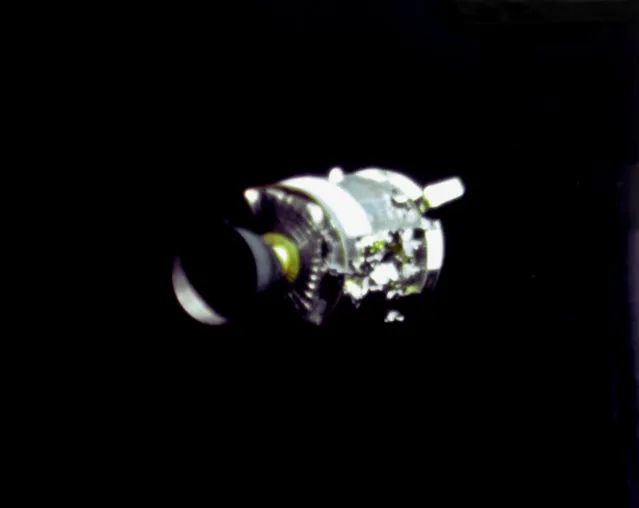
This view of the damaged Apollo 13 Service Module (SM) was photographed from the Lunar Module/Command Module following SM jettisoning. As seen here, an entire SM panel was blown away by the apparent explosion of oxygen tank number two located in Sector 4 of the SM. Two of the three fuel cells are visible just forward (above) the heavily damaged area. Three fuel cells, two oxygen tanks, and two hydrogen tanks are located in Sector 4. The damaged area is located above the S-Band high gain antenna. Nearest the camera is the Service Propulsion System (SPS) engine and nozzle. The damage to the SM caused the Apollo 13 crewmen to use the Lunar Module (LM) as a “lifeboat”. The Lunar Module “Aquarius” was jettisoned just prior to Earth reentry by the Command Module “Odyssey”. (Photo by NASA)
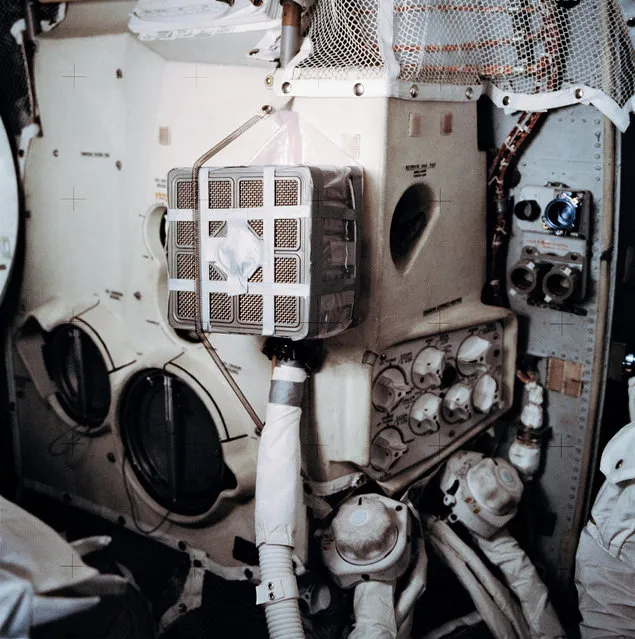
Interior view of the Apollo 13 Lunar Module (LM) showing the “mail box”, a jury-rigged arrangement which the Apollo 13 astronauts built to use the Command Module (CM) lithium hydroxide canisters to purge carbon dioxide from the LM. Lithium hydroxide is used to scrub CO2 from the spacecraft's atmosphere. Since there was a limited amount of lithium hydroxide in the LM, this arrangement was rigged up to utilize the canisters from the CM. The “mail box” was designed and tested on the ground at the Manned Spacecraft Center (MSC) before it was suggested to the problem-plagued Apollo 13 crew men. Because of the explosion of one of the oxygen tanks in the Service Module (SM), the three crew men had to use the LM as a “lifeboat”. 11-17 April 1970. (Photo by NASA)
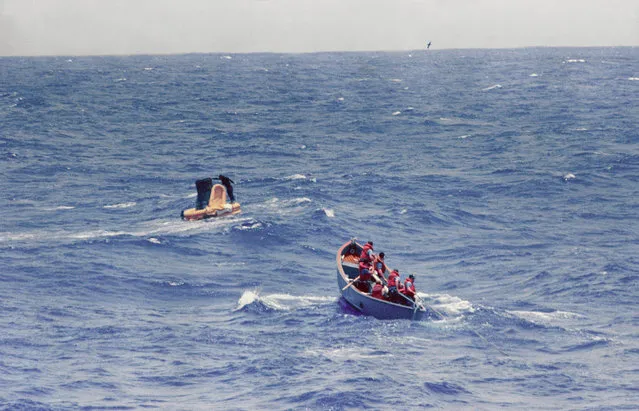
Navy Divers install a stabilizing flotation collar around Gordon Cooper's Mercury space capsule nicknamed Faith 7 shortly after splashdown. (Photo by NASA)
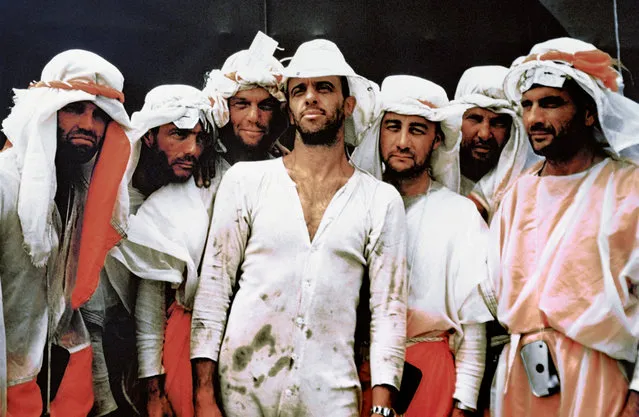
In this 1960 photograph, the seven original Mercury astronauts participate in U.S. Air Force survival training exercises at Stead Air Force Base in Nevada. Pictured here, from left to right are: L. Gordon Cooper, M. Scott Carpenter, John Glenn, Alan Shepard, Virgil I. Grissom, Walter Schirra and Donald K. Slayton. (Photo by NASA)
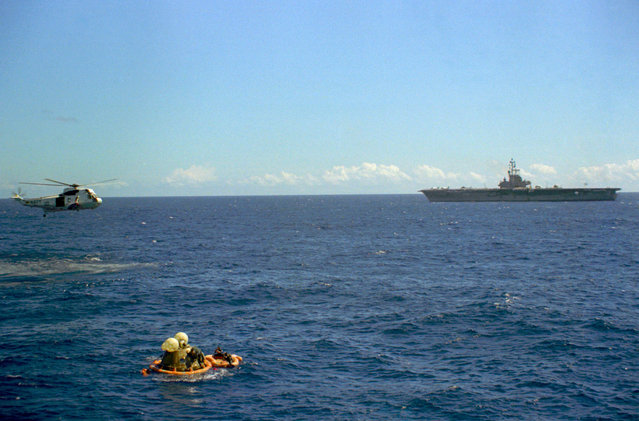
The Apollo 16 Command Module bobbles photographed in the waters of the central Pacific Ocean during recovery operations, on April 27, 1972. The prime recovery ship, USS Ticonderoga, is in the background. A recovery helicopter hovers overhead. The Apollo 16 crew, astronauts John W. Young, Thomas K. Mattingly II, and Charles M. Duke Jr., were picked up by helicopter and flown to the deck of the ship. The splashdown occurred at 290:37:06 ground elapsed time, 1:45:06 p.m. (CST), Thursday, April 27, 1972, at coordinates of 00:45.2 degrees south latitude and 156:11.4 degrees west longitude, a point approximately 215 miles southeast of Christmas Island. A team of Earth Landing System swimmers assisted with the recovery operations. (Photo by NASA)

The Augmented Target Docking Adapter (ATDA) as seen from the Gemini 9 spacecraft during one of their three rendezvous in space. The ATDA and Gemini 9 spacecraft are 66.5 ft. apart. Failure of the docking adapter protective cover to fully separate on the ATDA prevented the docking of the two spacecraft. The ATDA was described by the Gemini 9 crew as an “angry alligator”. (Photo by NASA)
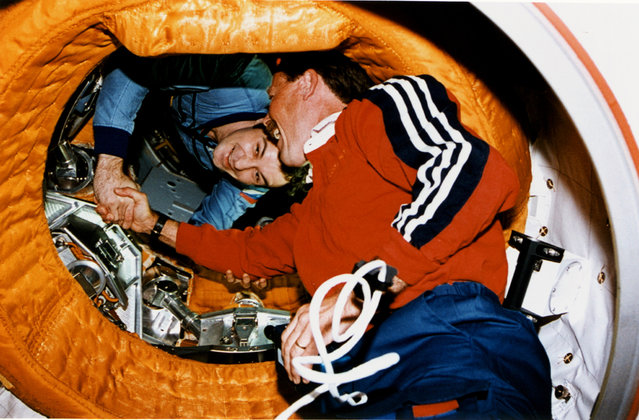
Astronaut Robert L. Gibson, STS-71 mission commander, shakes the hand of cosmonaut Vladimir N. Dezhurov, Mir-18 commander. The historic handshake took place two and a half weeks prior to the 20th anniversary of a similar in-space greeting between cosmonauts and astronauts participating in the Apollo-Soyuz Test Project (ASTP). On July 17, 1975, astronaut Thomas P. Stafford, NASA's ASTP commander, greeted his counterpart, Aleksey A. Leonov, in a docking tunnel linking the Soyuz and Apollo spacecraft. (Photo by NASA)
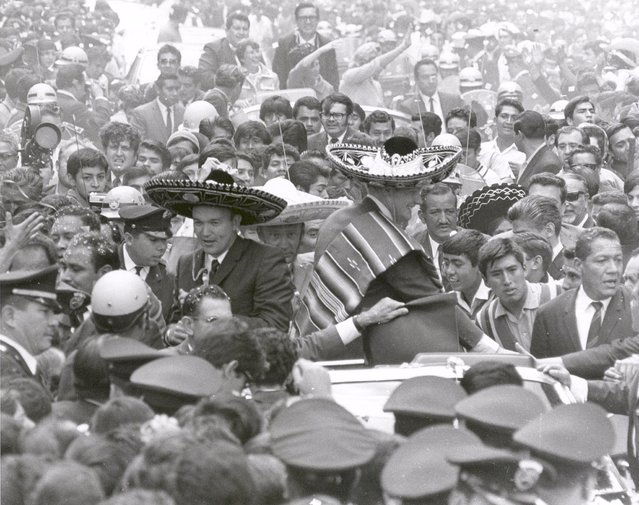
The Apollo 11 astronauts, Neil A. Armstrong, Edwin E. Aldrin, Jr., and Michael Collins, wearing sombreros and ponchos, are swarmed by thousands in Mexico City as their motorcade is slowed by the enthusiastic crowd. The GIANTSTEP-APOLLO 11 Presidential Goodwill Tour emphasized the willingness of the United States to share its space knowledge. The tour carried the Apollo 11 astronauts and their wives to 24 countries and 27 cities in 45 days. (Photo by NASA)
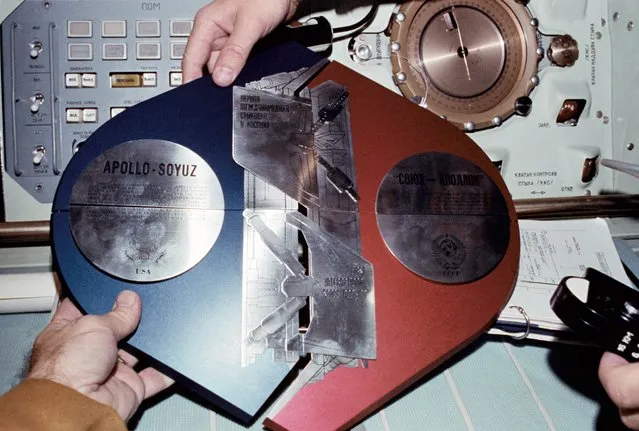
The Apollo-Soyuz Test Project (ASTP) Commemorative Plaque is assembled in the Soviet Soyuz Orbital Module during the joint U.S.-USSR Apollo-Soyuz Test Project docking mission in Earth orbit. The plaque is written both in English and Russian. 17-18 July 1975. (Photo by NASA)
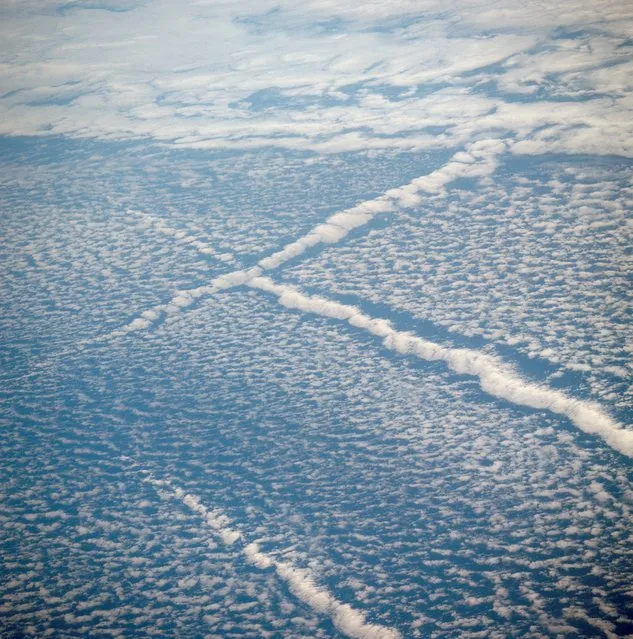
An oblique view of unique cloud patterns over the Pacific Ocean caused by aircraft contrail shadows altering cumulus clouds and forming straight line clouds, as photographed from the Apollo spacecraft in Earth orbit during the joint U.S.-USSR Apollo-Soyuz Test Project mission. This area is southwest of Los Angeles, California. This photograph was taken at an altitude of 177 kilometers (110 statute miles) with a 70mm Hasselblad camera using medium-speed Ektachrome, on July 16 1975. (Photo by NASA)
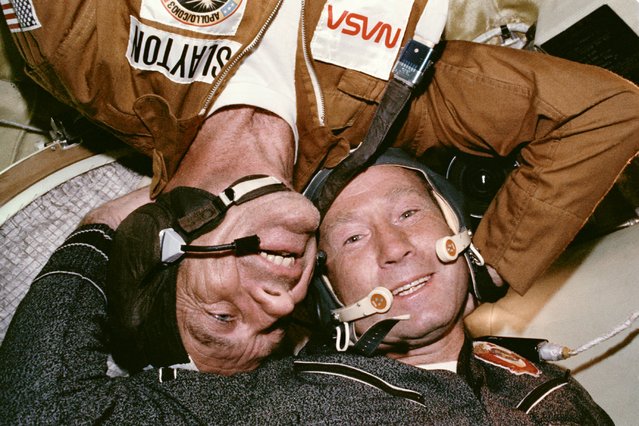
Astronaut Donald K. Slayton and cosmonaut Aleksey A. Leonov are seen together in the Soyuz Orbital Module during the joint U.S.-USSR Apollo-Soyuz Test Project docking mission in Earth orbit. Slayton is the docking module pilot of the American crew. Leonov is the Soviet crew commander. 17-19 July 1975. (Photo by NASA)
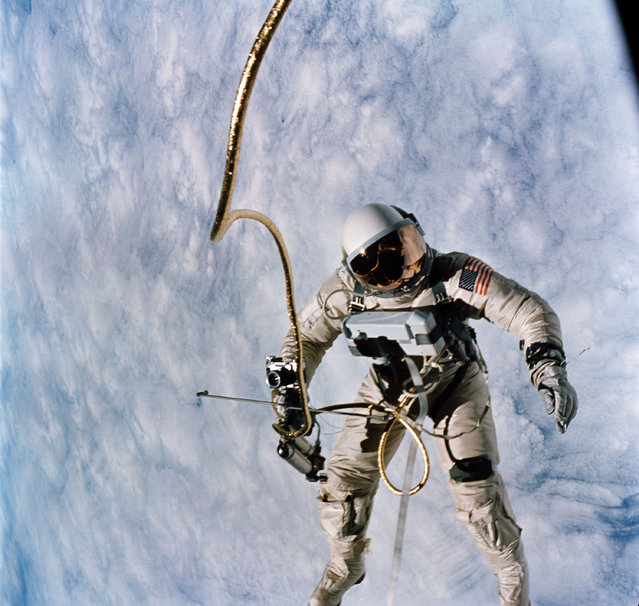
Astronaut Edward H. White II, pilot for the Gemini-Titan 4 (GT-4) spaceflight, floats in the zero-gravity of space during the third revolution of the GT-4 spacecraft on June 3, 1965. White wears a specially designed spacesuit. His face is shaded by a gold-plated visor to protect him from unfiltered rays of the sun. In his right hand he carries a Hand-Held Self-Maneuvering Unit (HHSMU) that gives him control over his movements in space. White also wears an emergency oxygen chest pack; and he carries a camera mounted on the HHSMU for taking pictures of the sky, Earth and the GT-4 spacecraft. He is secured to the spacecraft by a 25-feet umbilical line and a 23-feet tether line. Both lines are wrapped together in gold tape to form one cord. Astronaut James A. McDivitt, command pilot, remained inside the spacecraft during the extravehicular activity (EVA). (Photo by NASA)
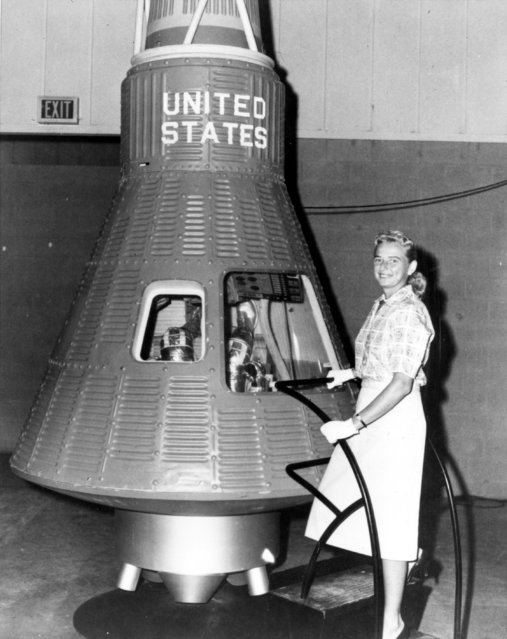
Jerrie Cobb poses next to a Mercury spaceship capsule. Although she never flew in space, Cobb, along with 24 other women, underwent physical tests similar to those taken by the Mercury astronauts with the belief that she might become an astronaut trainee. All the women who participated in the program, known as First Lady Astronaut Trainees (FLATs), were skilled pilots. Dr. Randy Lovelace, a NASA scientist who had conducted the official Mercury program physicals, administered the tests at his private clinic without official NASA sanction. Cobb passed all the training exercises, ranking in the top 2% of all astronaut candidates of both genders. Political pressure and internal opposition lead NASA to restrict its official astronaut training program to men despite campaigning by the 13 finalists of the FLAT program. (Photo by NASA)
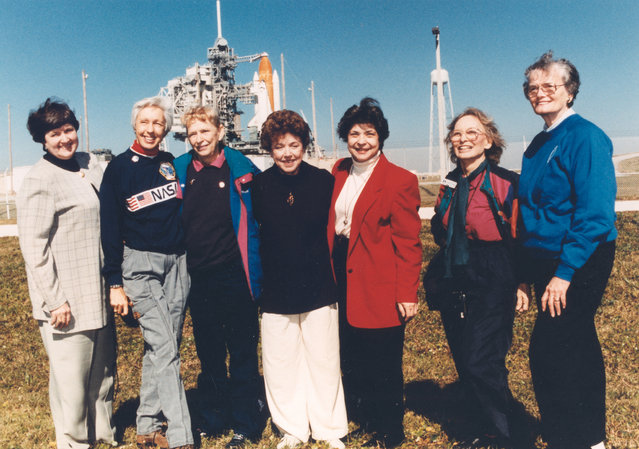
Exuberant and thrilled to be at the Kennedy Space Center, seven women who once aspired to fly into space stand outside Launch Pad 39B neat the Space Shuttle Discovery, poised for liftoff on the first flight of 1995. They are members of the First Lady Astronaut Trainees (FLATs, also known as the “Mercury 13”), a group of women who trained to become astronauts for Americas first human spaceflight program back in the early 1960s. Although this FLATs effort was never an official NASA program, their commitment helped pave the way for the milestone Eileen Collins set: becoming the first female Shuttle pilot. Visiting the space center as invited guests of STS-63 Pilot Eileen Collins are (from left): Gene Nora Jessen, Wally Funk, Jerrie Cobb, Jerri Truhill, Sarah Ratley, Myrtle Cagle and Bernice Steadman. (Photo by NASA)
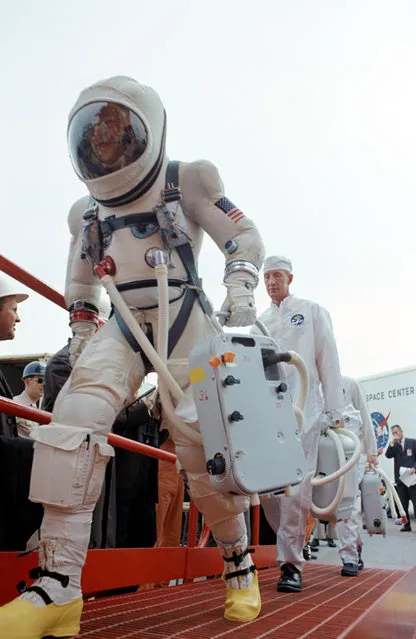
Astronaut James A. Lovell Jr., pilot for the National Aeronautics and Space Administration Gemini-7 spaceflight, walks to the elevator at Pad 19 one hour and 40 minutes before launch of the spacecraft, on December 4, 1965. Moments later astronauts Lovell and Frank Borman, command pilot, rode the elevator to the White Room where they were inserted into the spacecraft to await the final moments of the countdown. (Photo by NASA)
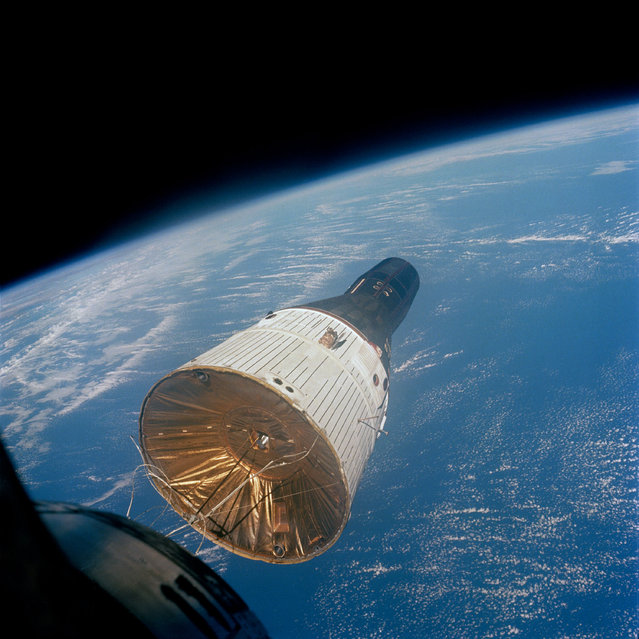
This photograph of the Gemini-Titan 7 (GT-7) spacecraft was taken from the Gemini-Titan 6 (GT-6) spacecraft during the historic rendezvous of the two spacecraft on December 15, 1965. The two spacecraft are some 37 feet apart here. Earth can be seen below. Astronauts Walter M. Schirra Jr., command pilot; and Thomas P. Stafford, pilot, were inside the GT-6 spacecraft, while crewmen for the GT-7 mission were astronauts Frank Borman, command pilot, and James A. Lovell Jr., pilot. (Photo by NASA)
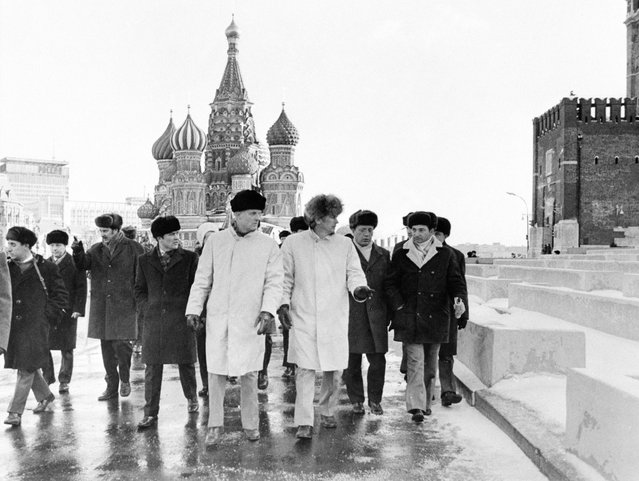
A group of astronauts and their cosmonaut hosts are photographed sightseeing on Red Square in the heart of Moscow during a tour of the Soviet capital, on November 1973. The Americans were in the USSR to participate in Apollo-Soyuz Test Project familiarization training on the Soyuz systems at the Cosmonaut Training Center (Star City) near Moscow. Astronaut Thomas P. Stafford (light coat, black cap), commander of the American ASTP crew, was head of the U.S. delegation to Star City. Astronaut Eugene A. Cernan (on Stafford's left, light coat) is the Special Assistant to the American Technical Director of ASTP. The sightseeing group is walking in the direction of Lenin's Mausoleum. The structure in the background is the Cathedral of the Intercession (St. Basil's) Museum. The historic Kremlin complex is to the right. (Photo by NASA/USSR Academy of Sciences)
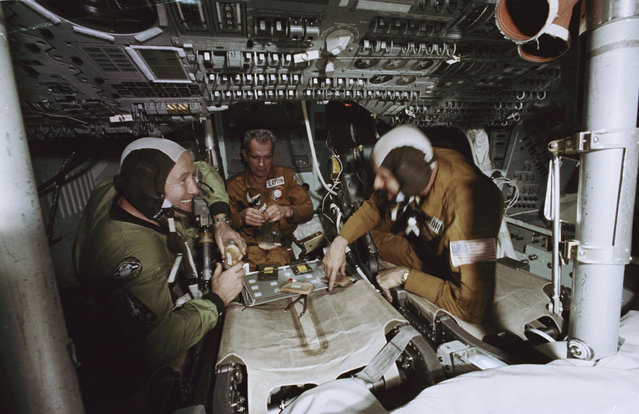
Three ASTP crewmen have a meal in the Apollo Command Module trainer in Building 35 during Apollo-Soyuz Test Project joint crew training at NASA's Johnson Space Center, on February 25, 1975. They are, left to right, cosmonaut Aleksey A. Leonov, commander of the Soviet ASTP first (prime) crew; astronaut Donald K. Slayton, docking module pilot of the American ASTP prime crew; and astronaut Thomas P. Stafford, commander of the American ASTP prime crew. The American and Soviet crewmen will visit each other's spacecraft when the Apollo and Soyuz are docked in Earth orbit. (Photo by NASA)
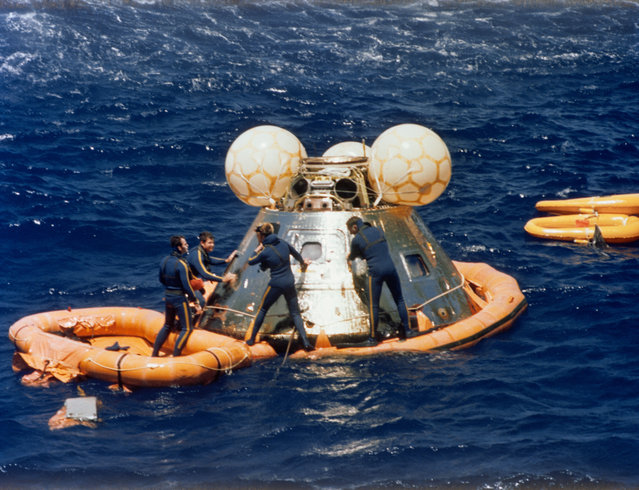
A team of U.S. Navy swimmers assists with the recovery of the ASTP Apollo Command Module following its splashdown in the Central Pacific Ocean to conclude the historic joint U.S.-USSR Apollo-Soyuz Test Project docking mission in Earth orbit, on July 24, 1975. The swimmers have already attached a flotation collar to the spacecraft. The CM touched down in the Hawaiian Islands area at 4:18 p.m. (CDT), July 24, 1975. The crewmen, astronauts Thomas P. Stafford, Vance D. Brand and Donald K. Slayton, remained in the CM until it was hoisted aboard the prime recovery ship, the USS New Orleans. (Photo by NASA)
22 Jul 2014 12:05:00,
post received
0 comments
